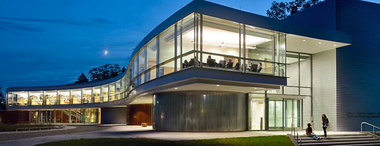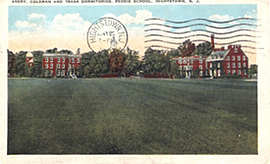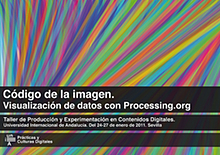Teaching with Sketchpad
If you teach workshops or classes with Processing, and are interested to try out Sketchpad with your students, get in touch to request a studio. I'd be happy to offer suggestions, connect you with others who have tried this in their classes, give you a guided tour, or simply answer your questions.
Canvas found in the studio gallery of a recent workshop that used Sketchpad:
Código de la imagen: visualización de datos con Processing.org
I'm starting to compile a list of interesting and meaningful ways that people have incorporated Sketchpad into classes. Some of these are from my own teaching experiences with Sketchpad, and many were contributed by others. If you have had success with techniques that I haven't listed below, please let me know and I'll add them to the list.
- Worked examples: You can prepare example sketches (with your own comments) for your students to work with. Rather than just reading the final code, they can follow along step-by-step, and re-render the sketch at any point along the way. We found this to be a useful way to demonstrate how to break down and approach a complex goal.
(For an example, try the playback functionality on this sketch)Sketchpad now includes a very powerful way for you to record narrated "sketchcasts" for your students to watch, pause, and experiment with code changes at any point in the playback. Read more about sketchcasting. - JIT Q&A: On a number of occasions, we would ask a "how could you modify this code to do X?" question. Different students had different ideas, and we let them take turns trying out their solutions, and letting others discuss and make suggestions. The discussions quickly got interesting with live code at the center of it. (This sketch was the center of a good discussion on possible approaches to have two objects move at different speeds, and this one was where we discussed RGB vs HSB.)
- Fork and fix: Occasionally, we would prepare a sketch that was slightly broken in a particular way. Participants would start by cloning that sketch, and trying to identify and fix the known bug. (an example)
- Variations on a theme: I saw a nice approach in Doug Holton's HTML5 course at USU, where he started his students off with a template sketch and let each student take it in their own creative direction. Juan Antonio Ruz did something similar with his course. Here are 33 variations on the theme, made by students on a sketch that he prepared.
- Group work: There's lots of cool sketches written by groups of students. The source code is color-coded by author, so you'll be able to see who contributed what.
- Understanding syntax: Understanding the importance of syntax is often a sticking point for people new to code. Having a second person on the sketch -- whether it's you or someone else -- can help keep people un-stuck and on track.
- Drawing attention to great work: Featuring student work in the Gallery is great for this. Juan Antonio Ruz did this with the codigodelaimagen studio gallery. (You'll need to request a private studio to do this yourself.)
- Have students replicate a "masterpiece": Sketchpad now features recreation as a fully-supported activity. You select the "masterpiece" canvas, and your students then attempt to re-create it with their own code.
- Ditch the projector: Amit Pitaru told me that he used Sketchpad in place of a projector for a workshop that he ran. He and his students were all on the same live sketch.
I think of https://studio.sketchpad.cc as an open studio. If you're teaching a class or workshop, you may like this model but need a bit more control over the experience. If so, you may want to looking into setting up your own sketchpad studio.
Some of courses & workshops that have used Sketchpad:










